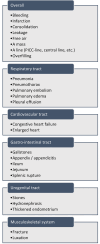Students' and junior doctors' perspectives on radiology education in medical school: a qualitative study in the Netherlands
- PMID: 38693517
- PMCID: PMC11062010
- DOI: 10.1186/s12909-024-05460-9
Students' and junior doctors' perspectives on radiology education in medical school: a qualitative study in the Netherlands
Abstract
Background: Modern medicine becomes more dependent on radiologic imaging techniques. Over the past decade, radiology has also gained more attention in the medical curricula. However, little is known with regard to students' perspectives on this subject. Therefore, this study aims to gain insight into the thoughts and ideas of medical students and junior doctors on radiology education in medical curricula.
Methods: A qualitative, descriptive study was carried out at one medical university in the Netherlands. Participants were recruited on social media and were interviewed following a predefined topic list. The constant comparative method was applied in order to include new questions when unexpected topics arose during the interviews. All interviews were transcribed verbatim and coded. Codes were organized into categories and themes by discussion between researchers.
Results: Fifteen participants (nine junior doctors and six students) agreed to join. From the coded interviews, four themes derived from fifteen categories arose: (1) The added value of radiology education in medical curricula, (2) Indispensable knowledge on radiology, (3) Organization of radiology education and (4) Promising educational innovations for the radiology curriculum.
Conclusion: This study suggests that medical students and junior doctors value radiology education. It provides insights in educational topics and forms for educational improvement for radiology educators.
Keywords: Learning objectives; Medical School Curriculum; Radiology Education; Students’ perspectives.
© 2024. The Author(s).
Conflict of interest statement
The authors declare no competing interests.
Figures
Similar articles
-
Radiology education for medical students: a qualitative exploration of educational topics, teaching methods and future strategies.BMC Med Educ. 2024 Aug 19;24(1):891. doi: 10.1186/s12909-024-05879-0. BMC Med Educ. 2024. PMID: 39160535 Free PMC article.
-
Why nutrition education is inadequate in the medical curriculum: a qualitative study of students' perspectives on barriers and strategies.BMC Med Educ. 2018 Feb 12;18(1):26. doi: 10.1186/s12909-018-1130-5. BMC Med Educ. 2018. PMID: 29433505 Free PMC article.
-
Musculoskeletal Radiology Teaching at a UK Medical School: Do We Need to Improve?Anat Sci Educ. 2019 May;12(3):257-263. doi: 10.1002/ase.1834. Epub 2018 Nov 5. Anat Sci Educ. 2019. PMID: 30395696
-
Medical professionalism in the formal curriculum: 5th year medical students' experiences.BMC Med Educ. 2014 Nov 30;14:259. doi: 10.1186/s12909-014-0259-0. BMC Med Educ. 2014. PMID: 25433816 Free PMC article.
-
Experiences of introducing planetary health topics to medical school curricula: A meta-ethnography.Med Teach. 2025 May 4:1-9. doi: 10.1080/0142159X.2025.2497898. Online ahead of print. Med Teach. 2025. PMID: 40319393 Review.
Cited by
-
Students' perspective on new teaching concepts for medical studies: case- and competency-based learning in radiology.Insights Imaging. 2025 Feb 6;16(1):31. doi: 10.1186/s13244-025-01909-7. Insights Imaging. 2025. PMID: 39913012 Free PMC article.
-
When Teratology and Augmented Reality Entwine: A Qualitative Phenomenological Analysis in a Museal Setting.Sensors (Basel). 2025 Jun 12;25(12):3683. doi: 10.3390/s25123683. Sensors (Basel). 2025. PMID: 40573568 Free PMC article.
References
MeSH terms
LinkOut - more resources
Full Text Sources
Miscellaneous




